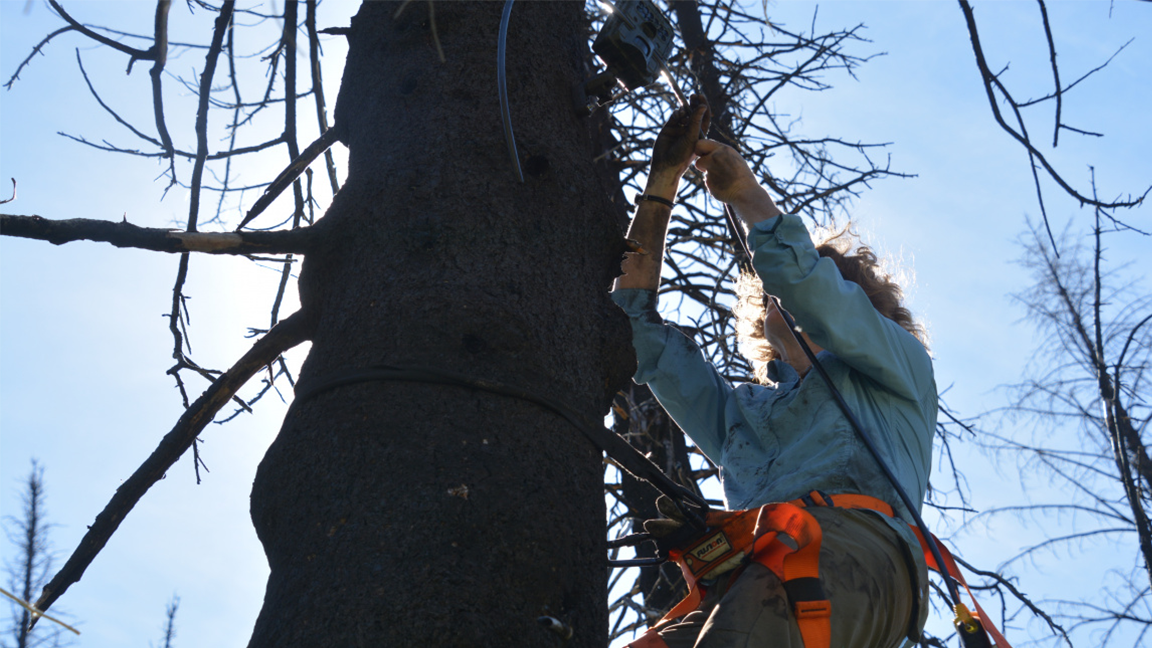For the first time since 2015, the Idaho Department of Fish and Game (IDFG) aims to produce an estimate of the total number of wolves in Idaho. To do so, staffers deployed more than 800 game cameras in a high-density grid throughout the state, which will take millions of pictures. When IDFG staffers collect the cameras at the end of September, researchers will download and analyze the photos and apply statistical modeling to estimate the population.
Sifting through millions of photos will be labor intensive, but Fish and Game Wildlife Research Manager Mark Hurley is aiming for early next year to have the most robust and accurate count of wolves ever in Idaho, and the first scientific population estimate since 2015.
Wolves were federally reintroduced into Idaho, Wyoming and Montana in 1995 and 1996. Between 1996 and 2005, Idaho’s wolf population was estimated using a “total count” technique to generate an estimate of the statewide population, which was appropriate when the total population was small and many wolves wore radio collars. Biologists could track individual animals back to their packs, get an estimate of pack sizes and then estimate the statewide population.
From 2006 to 2016, Fish and Game’s wolf monitoring program remained under federal oversight. Until May 2016, the department was required to maintain enough radio collared wolves to be able to demonstrate that there were more than 15 breeding pairs of wolves in that state and more than 150 total wolves. .
“This kind of monitoring was really targeted at federal Endangered Species Act recovery goals — that’s why we were doing that. That sort of effort works with very small populations,” Hurley said.
During this period, biologists counted the number of wolves within each pack from aircraft, or on the ground, during early winter, and used that information to calculate an average pack size. While they continued to count the actual number of wolves they spotted during surveys, wildlife managers also began using a new technique to estimate the statewide wolf population that was better suited to larger and more dispersed populations. They applied the average pack size in areas known to have packs, but where individual wolves were not necessarily seen and counted by a person.
As Idaho’s wolf population continued to grow, however, it became increasingly difficult to monitor the population. After wolves were removed from the endangered species list, Idaho took full management of them and hunters and trappers began harvesting wolves, it made keeping radio collars on wolves more difficult and costly.
“That monitoring used to cost about $750,000 per year, a large portion of which came from federal funding,” said Toby Boudreau, Fish and Game’s Wildlife Bureau Chief. “That funding tapered off from the time wolves were delisted in 2011 until it was eliminated in 2016.”
Idaho’s wildlife managers knew they would need to monitor wolf populations using a more cost-effective and efficient model than one based on radio collars, and the focus of their monitoring shifted to “occupancy” — or estimating the number of wolf packs in the state, rather than establishing a total wolf population estimate.
Beginning in 2016, researchers started using a grid of about 200 game cameras to detect whether or not wolf packs were present in predetermined areas scattered across the Idaho, which biologists call “occupancy cells.”
By determining what percentage of Idaho is occupied by wolf packs and monitoring changes over time, while also monitoring wolves’ impact on elk and deer populations, wildlife managers observed large-scale trends in the statewide wolf population, and managed wolves based on population trends, i.e. whether the overall population was stable, growing or shrinking.
“If the wolf population contracts, occupancies should contract, in the same way that they increase,” Hurley said. “You can also estimate the number of packs. That is what we can do with patch occupancy, because your occupancy cells are the size of a whole pack territory.”
Biologists also used DNA analysis from scat surveys and harvested wolves, allowing them to estimate pack counts, reproduction, and the number of wolves in small areas during the summer months. Using these methods alone, however, it was difficult to get an overall, statewide wolf population estimate.
That situation changed recently after researchers developed population-estimate techniques by using game cameras, similar to how biologists are already using cameras to count and monitor elk and deer populations in Idaho.
For the new method to work, wildlife managers needed to dramatically increase the number of cameras in the field devoted to wolf monitoring, which is why Fish and Game staff deployed hundreds of additional cameras this summer.
“What we’ve done is split these occupancy cells up again, and added additional cameras within them,” Hurley said. “That will give us enough cameras to generate an abundance estimate, which we can’t get with just the occupancy cameras.”
(Photo source: Idaho Department of Fish and Game & U.S. Fish and Wildlife Service)
